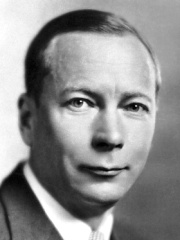
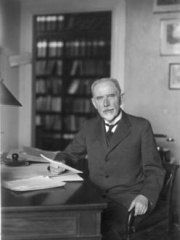
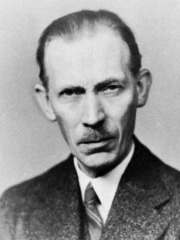
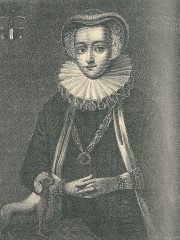
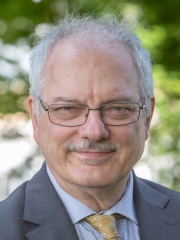
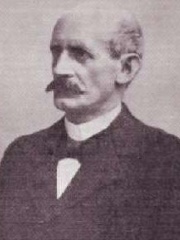
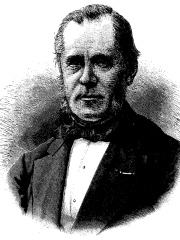
The Most Famous
CHEMISTS from Denmark
Top 8
The following people are considered by Pantheon to be the most legendary Danish Chemists of all time. This list of famous Danish Chemists is sorted by HPI (Historical Popularity Index), a metric that aggregates information on a biography's online popularity.

1. Henrik Dam (1895 - 1976)
With an HPI of 73.50, Henrik Dam is the most famous Danish Chemist. His biography has been translated into 60 different languages on wikipedia.
Carl Peter Henrik Dam (21 February 1895 – 17 April 1976) was a Danish biochemist and physiologist. He was awarded the Nobel Prize in Medicine in 1943 for joint work with Edward Doisy in discovering vitamin K and its role in human physiology. Dam's key experiment involved feeding a cholesterol-free diet to chickens. He initially replicated experiments reported by scientists at the Ontario Agricultural College (OAC). McFarlane, Graham and Richardson, working on the chick feed program at OAC, had used chloroform to remove all fat from chick chow. They noticed that chicks fed only fat-depleted chow developed hemorrhages and started bleeding from tag sites. Dam found that these defects could not be restored by adding purified cholesterol to the diet. It appeared that—together with the cholesterol—a second compound had been extracted from the food, and this compound was called the coagulation vitamin. The new vitamin received the letter K because the initial discoveries were reported in a German journal, in which it was designated as Koagulationsvitamin. He received an undergraduate degree in chemistry from the Copenhagen Polytechnic Institute (now the Technical University of Denmark) in 1920, and was appointed as assistant instructor in chemistry at the School of Agriculture and Veterinary Medicine. By 1923 he had attained the post of instructor in biochemistry at the University of Copenhagen's Physiological Laboratory. He studied microchemistry at the University of Graz under Fritz Pregl in 1925, but returned to the University of Copenhagen, where he was appointed as an assistant professor at the Institute of Biochemistry in 1928, and assistant professor in 1929. During his time as professor at the University of Copenhagen he spent some time working abroad, and in 1934 submitted the thesis Nogle Undersøgelser over Sterinernes Biologiske Betydning (Some Investigations on the Biological Significance of the Sterines) to the University of Copenhagen, and received the degree of PhD in biochemistry. Between 1942 and 1945 Dam was a senior research associate at the University of Rochester; it was during this period that he was awarded the 1943 Nobel Prize for Physiology or Medicine. In 1951, he was one of seven Nobel Laureates who attended the first Lindau Nobel Laureate Meeting.

2. S. P. L. Sørensen (1868 - 1939)
With an HPI of 72.52, S. P. L. Sørensen is the 2nd most famous Danish Chemist. His biography has been translated into 36 different languages.
Søren Peter Lauritz Sørensen (9 January 1868 – 12 February 1939) was a Danish chemist, known for the introduction of the concept of pH, a scale for measuring acidity and alkalinity.

3. Johannes Nicolaus Brønsted (1879 - 1947)
With an HPI of 70.11, Johannes Nicolaus Brønsted is the 3rd most famous Danish Chemist. His biography has been translated into 40 different languages.
Johannes Nicolaus Brønsted (Danish: [joˈhænˀəs ne̝koˈlɛːus ˈpʁɶnsteð]; 22 February 1879 – 17 December 1947) was a Danish physical chemist who is best known for developing the Brønsted–Lowry acid–base theory; he developed the theory at the same time as (but independently of) Martin Lowry.

4. Sophia Brahe (1556 - 1643)
With an HPI of 68.91, Sophia Brahe is the 4th most famous Danish Chemist. Her biography has been translated into 38 different languages.
Sophia (or Sophie) Thott Lange (née Brahe; 24 August 1559 or 22 September 1556 – 1643), known by her maiden name, was a Danish noblewoman and horticulturalist with knowledge of astronomy, chemistry, and medicine. She worked alongside her brother Tycho Brahe in making astronomical observations.
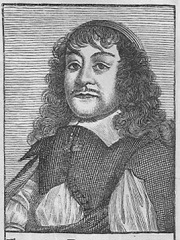
5. Rasmus Bartholin (1625 - 1698)
With an HPI of 65.67, Rasmus Bartholin is the 5th most famous Danish Chemist. His biography has been translated into 25 different languages.
Rasmus Bartholin (; Latinized: Erasmus Bartholinus; 13 August 1625 – 4 November 1698) was a Danish physician and grammarian.

6. Morten P. Meldal (b. 1954)
With an HPI of 63.71, Morten P. Meldal is the 6th most famous Danish Chemist. His biography has been translated into 45 different languages.
Morten Peter Meldal (born 16 January 1954) is a Danish chemist and Nobel laureate. He is a professor of chemistry at the University of Copenhagen in Copenhagen, Denmark. He is best known for developing the CuAAC-click reaction, concurrently with but independent of Valery V. Fokin and K. Barry Sharpless.

7. Johan Kjeldahl (1849 - 1900)
With an HPI of 58.93, Johan Kjeldahl is the 7th most famous Danish Chemist. His biography has been translated into 20 different languages.
Johan Gustav Christoffer Thorsager Kjeldahl (Danish pronunciation: [joˈhæn ˈkʰelˌtɛˀl] 16 August 1849 – 18 July 1900), was a Danish chemist who developed a method for determining the amount of nitrogen in certain organic compounds using a laboratory technique which was named the Kjeldahl method after him.

8. Hans Peter Jørgen Julius Thomsen (1826 - 1909)
With an HPI of 57.92, Hans Peter Jørgen Julius Thomsen is the 8th most famous Danish Chemist. His biography has been translated into 20 different languages.
Hans Peter Jørgen Julius Thomsen (16 February 1826 – 13 February 1909) was a Danish chemist noted in thermochemistry for the Thomsen–Berthelot principle.
People
Pantheon has 8 people classified as Danish chemists born between 1556 and 1954. Of these 8, 1 (12.50%) of them are still alive today. The most famous living Danish chemists include Morten P. Meldal. The most famous deceased Danish chemists include Henrik Dam, S. P. L. Sørensen, and Johannes Nicolaus Brønsted.
Living Danish Chemists
Go to all RankingsDeceased Danish Chemists
Go to all RankingsHenrik Dam
1895 - 1976
HPI: 73.50
S. P. L. Sørensen
1868 - 1939
HPI: 72.52
Johannes Nicolaus Brønsted
1879 - 1947
HPI: 70.11
Sophia Brahe
1556 - 1643
HPI: 68.91
Rasmus Bartholin
1625 - 1698
HPI: 65.67
Johan Kjeldahl
1849 - 1900
HPI: 58.93
Hans Peter Jørgen Julius Thomsen
1826 - 1909
HPI: 57.92
Overlapping Lives
Which Chemists were alive at the same time? This visualization shows the lifespans of the 5 most globally memorable Chemists since 1700.

